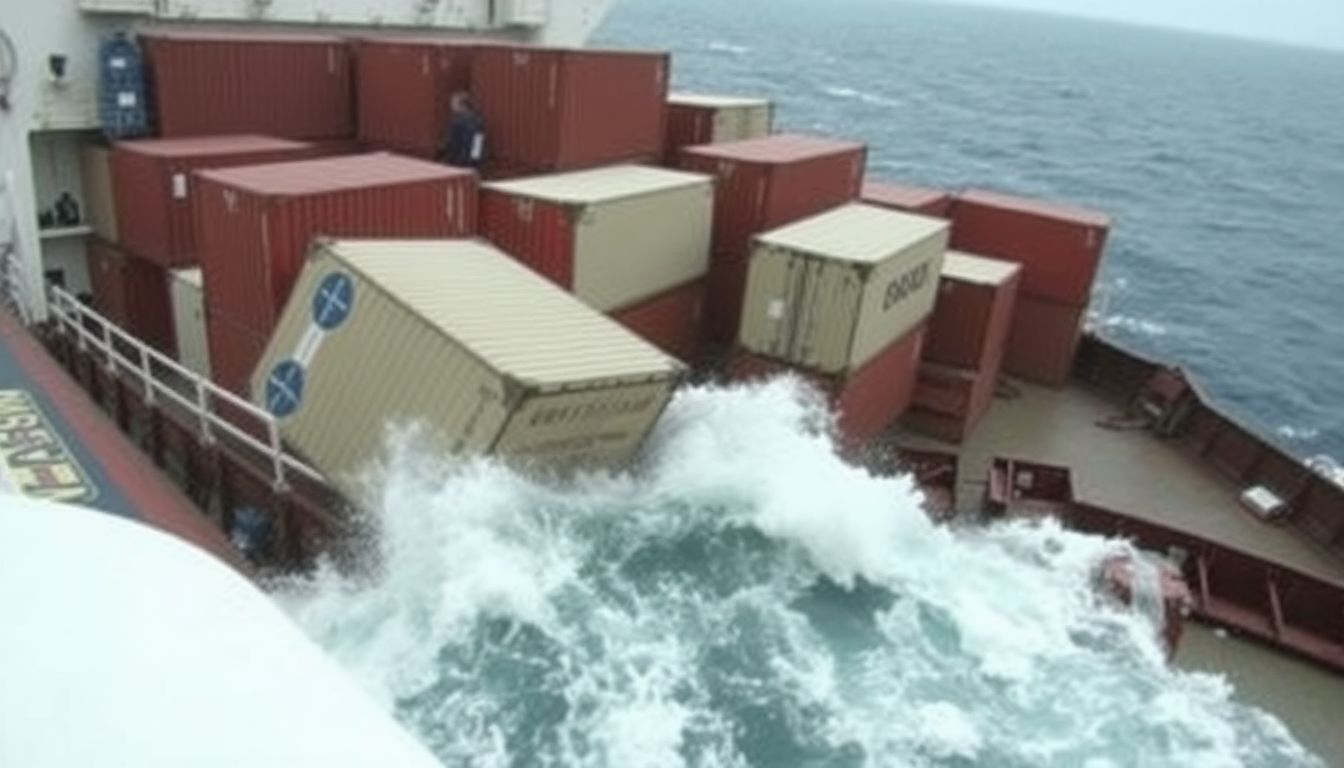Cargo ship accidents can cause major losses for businesses. Each year, these incidents result in billions of dollars in damaged or lost goods. This article will guide you through the process of filing cargo ship accident claims.
Learn how to protect your interests and seek fair compensation.
Key Takeaways
- Cargo ship accidents cost billions in damages yearly, often caused by weather, poor loading, and crew errors.
- Recent major accidents include the March 26, 2024 Baltimore bridge collapse and the February 22, 2024 China bridge crash.
- The Carriage of Goods by Sea Act (COGSA) sets rules for cargo claims, giving one year to file after delivery.
- To file a claim, notify the carrier quickly, gather documents, take photos, fill out forms, and follow up regularly.
- Maritime lawyers can help navigate complex legal issues and secure fair compensation for injuries or cargo damage.
Common Causes of Cargo Ship Accidents

Cargo ship accidents often stem from a mix of human error and natural factors. Rough weather conditions, like storms and high waves, can toss ships and their cargo around. Poor loading practices also play a big role.
Crews sometimes pack containers wrong or don’t secure cargo well enough. This can lead to shifts during travel, causing accidents. Aging vessels and lax safety standards increase risks too.
Crew training gaps can result in mistakes that lead to disasters.
Safety at sea is not a matter of luck, but of proper preparation and vigilance.
Recent events show how serious these issues can be. On March 26, 2024, the Francis Scott Key Bridge in Baltimore collapsed after a ship hit it. The crash left six workers missing. Just a month earlier, on February 22, a cargo ship crashed into the Lixinsha Bridge in China.
That accident killed five people and sent vehicles falling into the water. These cases highlight the need for better safety measures in maritime shipping.
Types of Cargo Damage in Accidents
Moving from the causes of cargo ship accidents, we now focus on the types of damage that can occur. Cargo damage falls into four main groups: loss, shortage, general damage, and concealed damage.
Loss happens when items go missing or aren’t delivered. Shortage means fewer items arrive than were sent. General damage is easy to spot upon arrival, while concealed damage shows up later.
Physical harm, wet damage, and contamination are common issues in cargo accidents. Reefer-related problems and pest infestations also cause trouble. Poor stowage leads to many of these issues.
In fact, 14% of cargo damages stem from wrong temperature control. I’ve seen firsthand how proper packing and handling can prevent most of these problems. Careful planning and skilled workers make a big difference in keeping goods safe during shipping.
Legal Framework for Cargo Ship Accident Claims
The Carriage of Goods by Sea Act (COGSA) sets the rules for cargo loss or damage claims in foreign trade. This law limits shipowners’ liability for certain events like acts of God, war, or fires not caused by their negligence.
COGSA gives claimants one year from delivery to file their case. As a maritime lawyer, I’ve seen many cases where this time limit caught clients off guard. It’s crucial to act fast after an accident.
For seafarer injuries, the Jones Act allows claims against employers or vessel owners. This law protects workers’ rights at sea. In my practice, I’ve helped injured crew members get fair compensation under the Jones Act.
These laws form the backbone of cargo ship accident claims, guiding how cases are handled and resolved in U.S. courts.
Steps to File a Claim for Lost or Damaged Cargo
After understanding the legal framework, you must know how to file a claim for lost or damaged cargo. Filing a freight claim involves specific steps to request compensation from the carrier. Here’s a detailed guide on how to file a claim for lost or damaged cargo:
- Notify the carrier immediately: Contact the shipping company as soon as you discover the loss or damage. Most carriers require notification within a set timeframe, often 24 to 48 hours.
- Gather essential documents: Collect your Bill of Lading, invoice, and proof of loss or damage. These papers form the backbone of your claim and prove ownership and value.
- Document the damage: Take clear photos and videos of the damaged cargo. If possible, have an independent inspector assess and report on the damage.
- Fill out the claim form: Complete the carrier’s official claim form with accurate details about the shipment, damage, and requested compensation.
- Submit the claim: Send your completed form and supporting documents to the carrier within the allowed time frame, typically nine months for concealed damage.
- Follow up regularly: Keep track of your claim’s progress by contacting the carrier periodically. Ask for updates and provide any additional information they might need.
- Consider legal help: If the carrier denies your claim or offers insufficient compensation, consult a maritime lawyer for expert advice on your next steps.
When to Contact a Maritime Lawyer
Cargo ship accident claims can be complex. You need expert help to navigate legal waters. A maritime lawyer can guide you through the process and fight for your rights. Don’t wait to seek legal advice if you’ve been involved in a cargo ship accident.
Act now to protect your interests and get the compensation you deserve.
7. Compensation You Can Claim.
Compensation You Can Claim
After consulting a maritime lawyer, you’ll need to understand the types of compensation available. Seamen injured on cargo ships can claim various benefits under the Jones Act. These include coverage for medical care costs and wage loss during recovery.
Our firm has helped many sailors get full payment for their hospital bills and lost income.
Maritime workers also have rights to “maintenance and cure” compensation. This pays for daily living expenses and medical treatment until you reach maximum medical improvement. In cases of fatal accidents, families can seek wrongful death damages.
These may cover lost future income and funeral costs. We’ve assisted numerous families in securing fair settlements after losing loved ones at sea.
Supplementary insights on Cargo Ship Accident Claims
Cargo ship accident claims involve complex legal issues. Understanding key aspects can help you protect your rights and seek fair compensation.
What to Do Immediately After a Cargo Ship Accident
Cargo ship accidents require swift action to ensure safety and protect legal rights. Follow these steps immediately after a cargo ship accident:
- Ensure safety: Check for injuries and provide first aid if needed. Move to a safe area if possible.
- Call for help: Contact emergency services right away. Give clear details about the accident and location.
- Document the scene: Take photos and videos of the damage. Note weather conditions and any visible causes.
- Gather information: Collect names and contact details of witnesses and other involved parties.
- Report to authorities: Inform the Coast Guard and port officials about the incident.
- Secure cargo: If safe, take steps to protect remaining cargo from further damage.
- Seek medical care: Get medical help for all injured crew members, even for minor injuries.
- Contact your company: Inform your employer or ship owner about the accident.
- Preserve evidence: Keep all relevant documents, logs, and records safe.
- Consult a lawyer: Reach out to a maritime lawyer upon arriving at the port of call.
- File a report: Complete an accident report with all the details you’ve gathered.
- Follow up: Stay in touch with your company and lawyer for next steps.
How to Document Damage and Loss
Proper documentation of cargo damage and loss is crucial for successful claims. Shippers must gather evidence to prove carrier fault and validate their claims. Here’s how to document damage and loss effectively:
- Inspect cargo immediately upon arrival. Check for visible damage, shortages, or signs of tampering.
- Take clear, detailed photos of damaged items. Include close-ups and wide shots to show the extent of the damage.
- Make written notes describing the type and severity of damage. Include dates, times, and locations of inspections.
- Preserve all shipping documents, including bills of lading and packing lists. These prove the cargo’s original condition.
- Request a joint survey with the carrier’s representative. This creates an official record of the damage.
- Collect statements from witnesses who saw the damage or loss. Include their contact information for follow-up.
- Keep samples of damaged goods, if possible. These can serve as physical evidence during the claim process.
- File a formal claim with the carrier within the specified timeframe. Most carriers require claims within 3-9 months.
- Provide proof of the cargo’s value through invoices or market price data. This helps determine compensation amounts.
- Document any steps taken to mitigate further damage. This shows you acted responsibly after discovering the issue.
- Maintain a timeline of all communications with the carrier about the claim. Include dates, names, and conversation summaries.
- Hire an independent surveyor for large or complex claims. Their expert assessment can strengthen your case.
Importance of Legal Representation
Legal representation is vital in cargo ship accident claims. Lawyers with maritime expertise can skillfully guide clients through the complex discovery process. They conduct thorough investigations, gathering key evidence like photos and witness statements.
This careful approach often leads to stronger cases and better outcomes for clients.
Attorneys play a crucial role in timely accident scene analysis. They quickly collect evidence and secure witness testimony before it’s lost or forgotten. Our firm has seen firsthand how fast action can make or break a case.
Expert legal counsel can significantly boost the value of your claim through their deep understanding of maritime law and injury cases.
The next section will explore the steps to file a claim for lost or damaged cargo.
Conclusion
Cargo ship accident claims can be complex. Understanding your rights and the legal process is key. Quick action and proper documentation boost your chances of fair compensation. A skilled maritime lawyer guides you through the claim process.
With the right knowledge and support, you can protect your interests after a cargo ship accident.
For more detailed information on navigating legal claims in different circumstances, check out our guide on how to file a lawsuit for laser hair removal burn injuries.
FAQs
1. What steps should I take after a cargo ship accident?
First, ensure everyone’s safety. Then, document the incident thoroughly. Take photos, gather witness statements, and collect all relevant paperwork. Report the accident to proper authorities and your insurance company. Seek medical attention for any injuries, even if they seem minor. Finally, contact a maritime lawyer to protect your rights and guide you through the claims process.
2. How long do I have to file a cargo ship accident claim?
Time limits for filing claims vary based on the accident type and location. Generally, you have three years from the incident date to file a claim. However, some cases may have shorter deadlines. It’s crucial to act quickly and consult a legal expert to avoid missing important deadlines that could affect your claim’s validity.
3. What compensation can I expect from a cargo ship accident claim?
Compensation depends on various factors, including injury severity, property damage, and lost wages. You may receive payment for medical expenses, rehabilitation costs, pain and suffering, and lost earning capacity. In cases of severe negligence, punitive damages might apply. A skilled maritime attorney can help you determine the full value of your claim and fight for fair compensation.
4. How can I prove liability in a cargo ship accident claim?
Proving liability requires strong evidence. Gather accident reports, maintenance logs, and crew statements. Expert testimony may be necessary to show negligence or equipment failure. Weather data and navigational records can also support your case. Your lawyer will help collect and present this evidence effectively to establish liability and strengthen your claim.
References
- https://www.mikegingerich.com/blog/5-common-causes-of-cargo-ship-accidents-you-need-to-know/
- https://ifa-forwarding.net/blog/international-freight-forwarding/cargo-damage-types-and-impact/ (2023-02-20)
- https://arviem.com/the-basics-that-everyone-must-know-about-cargo-damage/ (2020-03-24)
- https://www.vbattorneys.com/blog/unpacking-container-ship-accidents-causes-compensation-and-legal-considerations (2023-10-26)
- https://www.freightos.com/freight-blog/make-freight-claim/
- https://www.morrisbart.com/faqs/what-damages-can-be-recovered-in-a-jones-act-claim/
- https://www.thefafirm.com/blog/jones-act-eligibility-injured-at-sea/ (2023-11-20)
- https://www.wnyinjurylawyers.com/steps-to-take-immediately-after-a-boat-accident/
- https://www.prestoneasley.com/blog/what-are-the-8-important-things-to-do-during-a-ship-collision-accident/
- https://www.gofclogistics.com/a-complete-guide-to-freight-claims/
- https://www.gsa.gov/policy-regulations/policy/transportation-management-policy/freight-damage-claims-faqs (2023-06-12)
- https://www.lattianderson.com/next-steps/how-latti-anderson-investigates-an-accident-or-death/
- https://www.arnolditkin.com/offshore-injuries/cargo-ship-accidents/ (2024-03-26)

